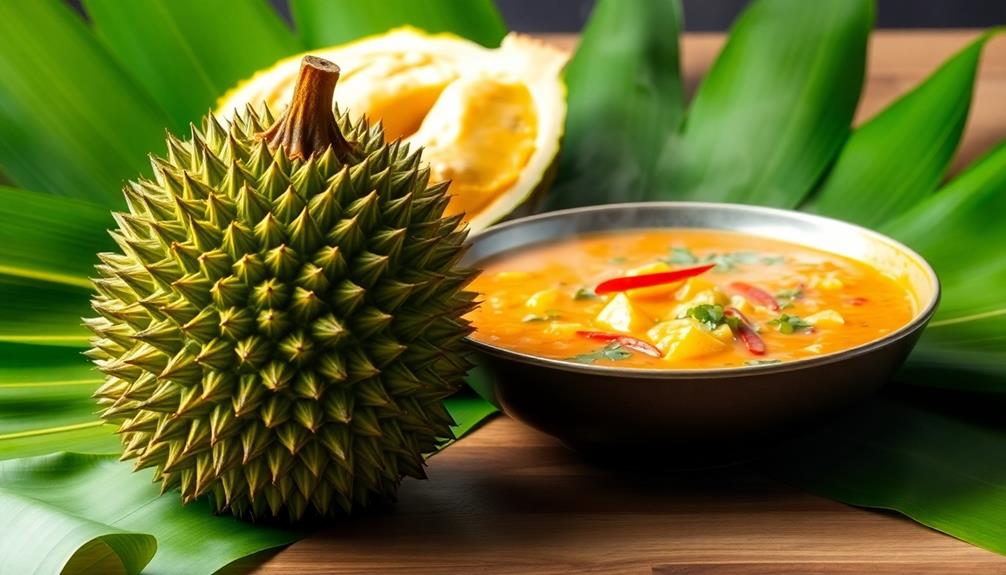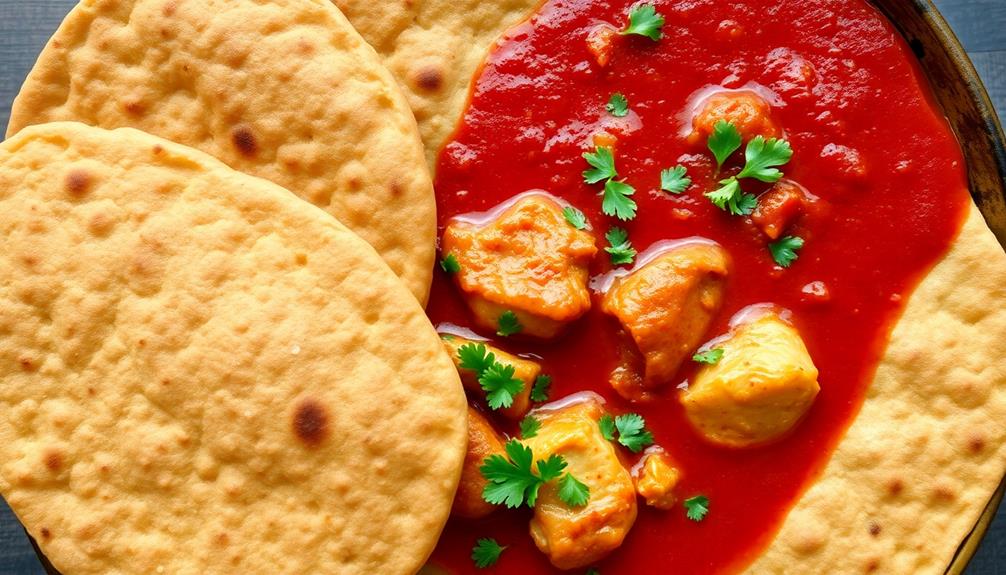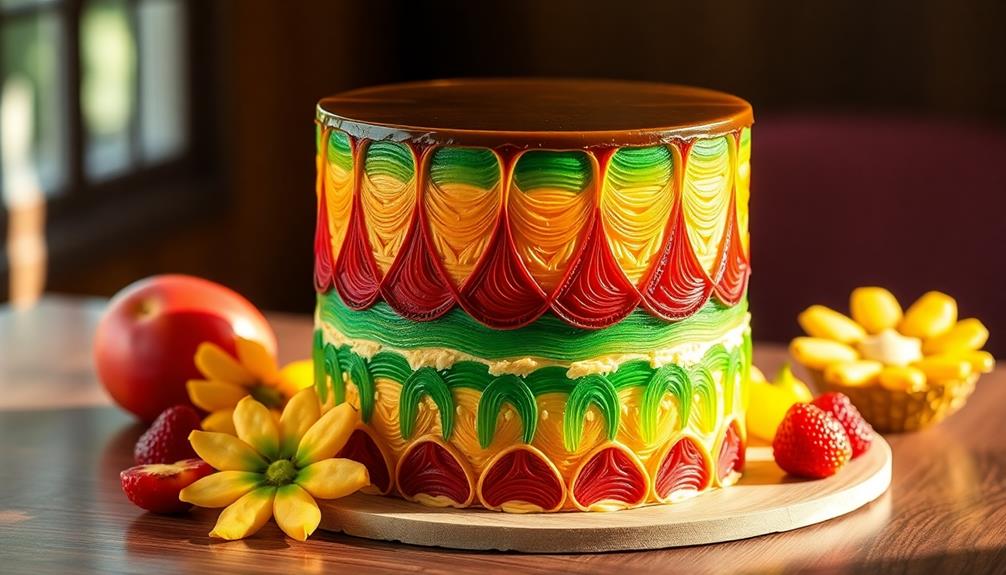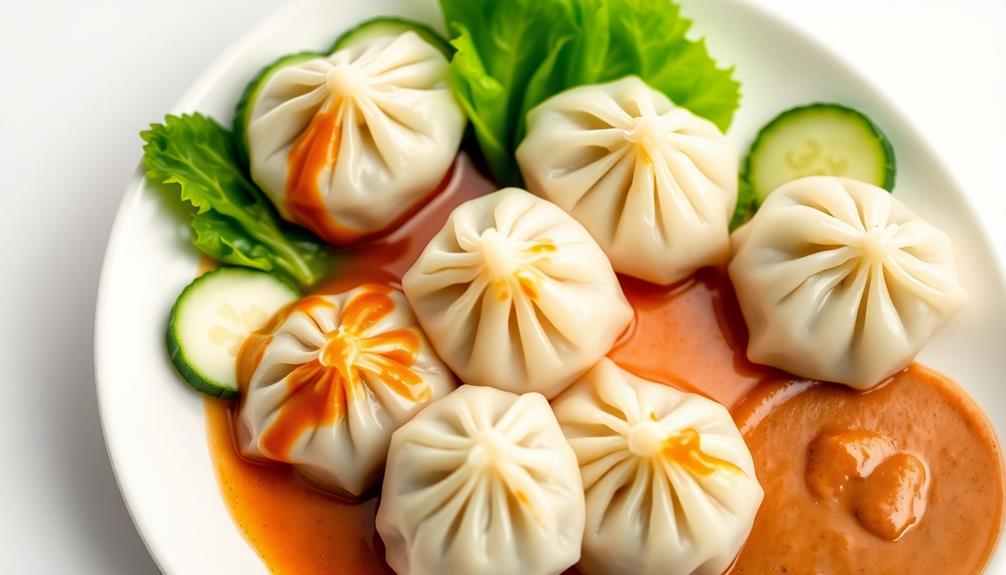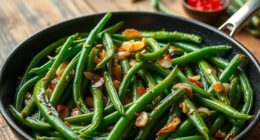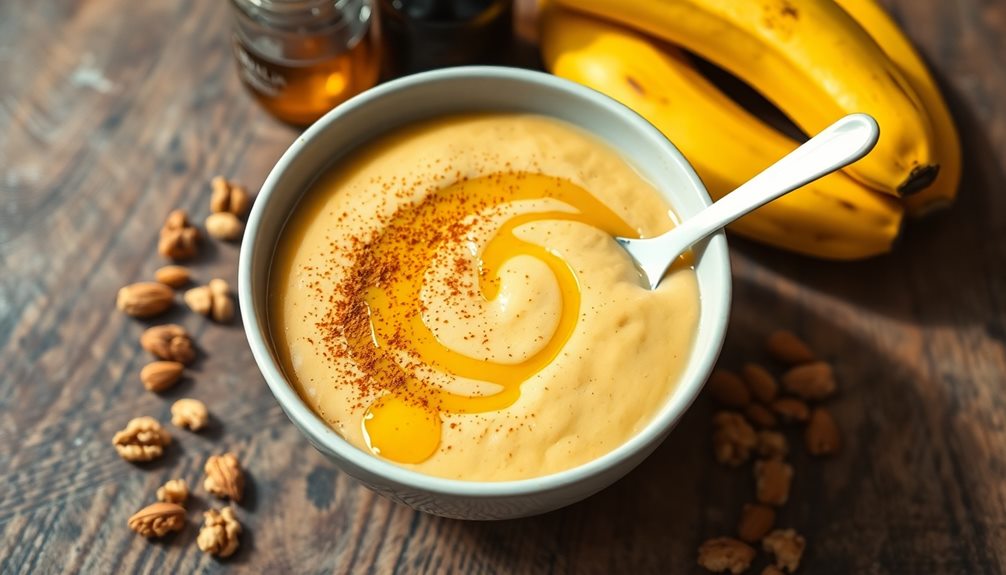Durian, the "king of fruits," has captivated culinary enthusiasts worldwide with its distinctive flavor and versatility. Rooted in Southeast Asian cuisine, this pungent tropical fruit offers a delightful journey for the open-minded. Carefully crack open the spiky shell to reveal the creamy flesh, then blend it into silky smoothies or sauté it with spices. Pair the rich durian with complementary ingredients like coconut milk and sticky rice for a harmonious experience. While the pungent aroma may challenge some, patience and experimentation are essential to unlock the depth of durian's gastronomic potential.
Key Takeaways
- Durian has a long history and cultural significance as a revered culinary ingredient in Southeast Asian cuisine.
- Durian is known for its unique flavor profile, ranging from sweet to savory, and its creamy, nutrient-dense flesh.
- Cooking with durian offers health benefits, such as providing energy, supporting heart health, and boosting immune function.
- Durian can be incorporated into a variety of sweet and savory dishes, including desserts, curries, and rice-based preparations.
- Proper preparation techniques, such as opening the fruit, removing the flesh, and blending or cooking it, are crucial for successfully utilizing durian in recipes.
History
Durian's history as a culinary ingredient dates back centuries, with evidence of its use in Southeast Asian cuisines as early as the 13th century. The pungent, spiky fruit has long been revered in the region, with its unique flavor and texture playing a central role in traditional dishes.
Over time, the popularity of durian has spread globally, capturing the imagination of adventurous eaters and sparking a culinary renaissance.
Today, durian's versatility is celebrated by chefs and home cooks alike, who incorporate it into a wide range of sweet and savory preparations. From creamy durian ice cream to savory durian curries, the fruit's rich, custard-like flesh lends itself beautifully to both sweet and savory applications.
As durian's global appeal continues to grow, its history as a beloved ingredient in Southeast Asian cuisine remains a testament to its enduring culinary significance.
Recipe
Durian, the divisive tropical fruit with a pungent aroma and a unique, creamy texture, can be a delightful ingredient when incorporated into the right dishes. While its distinctive flavor may not appeal to everyone, those who embrace it can discover a world of culinary possibilities.
When used judiciously, durian can lend a luxurious creaminess and a subtle sweetness to both savory and sweet preparations. Its versatility allows it to shine in various Southeast Asian cuisines, as well as in fusion dishes that highlight its distinctive qualities.
- 2 ripe durians, peeled and flesh removed
- 1 cup coconut milk
- 1/2 cup granulated sugar
- 1/2 teaspoon salt
- 2 cups glutinous rice, soaked for at least 4 hours or overnight
- Pandan leaves (optional)
In a large pot, combine the durian flesh, coconut milk, sugar, and salt. Bring the mixture to a gentle simmer, stirring occasionally, until the sugar has dissolved and the flavors have melded, about 15-20 minutes.
Meanwhile, steam the soaked glutinous rice until tender, about 25-30 minutes.
When ready to serve, scoop the steamed glutinous rice into bowls and top with the warm durian custard. Garnish with pandan leaves, if desired. This dish is best enjoyed warm, as the contrast between the warm, creamy durian and the chewy, sticky rice creates a delightful textural experience. To complete the sensory experience, pair this delightful dessert with a refreshing beverage like iced pandan tea or coconut water. For a full Southeast Asian culinary experience, consider serving this durian and glutinous rice dessert after a meal of traditional Indonesian dishes, such as rendang or sate. And if you’re looking to add more Indonesian flavors to your repertoire, try your hand at an authentic asinan recipe for a tasty and tangy salad.
Cooking Steps
Crack open the durian shell with a sturdy knife.
Scoop out the creamy flesh and blend it into a smooth puree.
Then, cook the durian puree and serve it warm alongside sticky rice for a truly indulgent experience.
Step 1. Crack Open the Durian Shell

Carefully, you'll want to commence the process of cracking open the durian's tough, spiky exterior. Using a sharp knife, slowly work your way around the fruit, cutting through the thick, thorny rind. Be mindful of the strong, pungent odor that will likely fill the air.
Once you've made a full circumference, firmly grasp the two halves and gently pull them apart. Inside, you'll find the bright yellow, creamy flesh nestled between the large, inedible seeds. Using a spoon, scoop out the precious durian pulp, being careful to avoid the bitter rind.
Durian's complex, savory-sweet flavor makes it a polarizing fruit, but its unique taste is undoubtedly worth the effort. Crack open the durian with care, and you'll be rewarded with a culinary experience like no other.
Prepare to be captivated by the intense aroma and indulgent texture of this remarkable tropical delight.
Step 2. Remove the Flesh

With the durian's tough exterior now breached, you can move on to extracting the creamy flesh within.
Gently pry open the fruit, being mindful of the sharp edges. Scoop out the pale yellow segments, taking care not to lose any precious flesh. The texture is soft and luxurious, like custard or crème brûlée. Discard any stringy bits or hard seeds as you go.
Work quickly, as the flesh can oxidize and darken if left exposed. Once you've collected all the usable flesh, give it a gentle rinse to remove any debris or lingering odor.
The durian's pungent aroma may linger, but the flavor is worth it. Now you're ready to incorporate this unique tropical treasure into your culinary creations.
Step 3. Blend the Durian Flesh
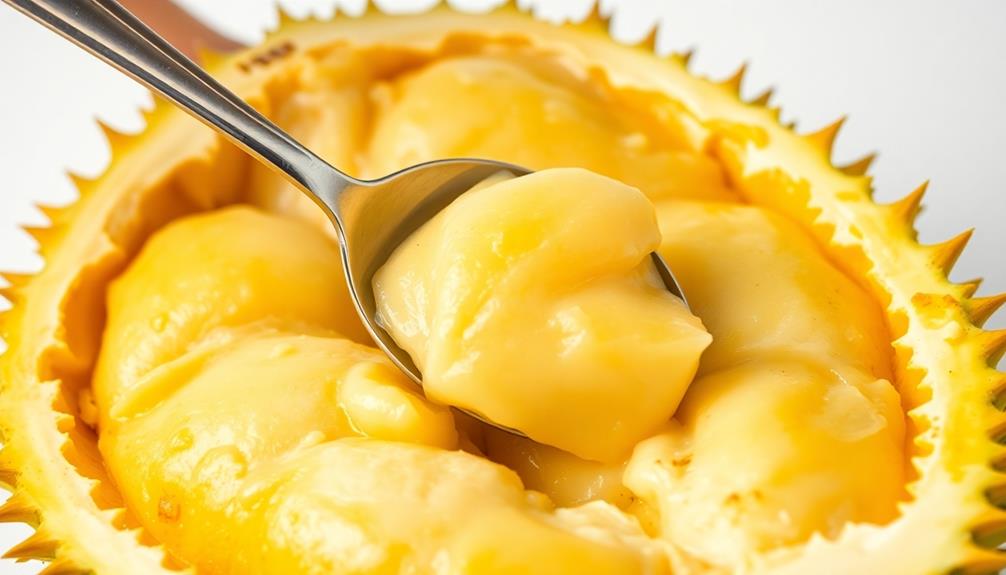
Once you've collected the durian flesh, it's time to blend it into a smooth, creamy texture. Start by transferring the durian flesh into a high-powered blender or food processor.
Add a splash of water or coconut milk to help the blending process. Pulse the mixture, gradually increasing the speed, until the durian is completely broken down and the texture is silky-smooth.
Be careful not to overmix, as this can cause the durian to become too liquid. Aim for a thick, velvety consistency that's perfect for incorporating into your cooking.
Taste the blended durian and adjust the consistency as needed, adding more liquid for a thinner texture or letting it blend a bit longer for a thicker, creamier result.
With the durian flesh now blended to perfection, you're ready to explore the diverse culinary applications of this unique and flavorful ingredient.
Incorporate the durian puree into sweet or savory dishes, or use it as a base for sauces, dips, and more.
Step 4. Cook the Durian Flesh
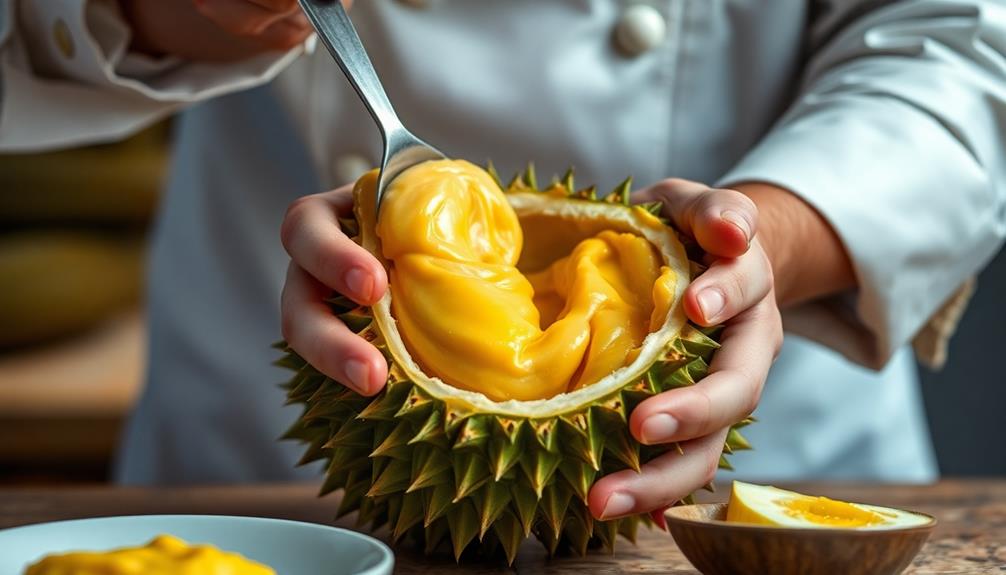
The durian flesh, now smoothly blended, offers a versatile canvas for your culinary creations.
You can sauté the durian flesh with fragrant spices like garlic, shallots, and chili to create a savory side dish.
Alternatively, you can fold the durian purée into a rich custard base and bake it into a decadent crème brûlée.
For a unique twist on a classic, try incorporating the durian flesh into pancake or waffle batter for a tropical breakfast treat.
If you're feeling adventurous, experiment by blending the durian into a smoothie or milkshake, adding a touch of sweetness from honey or coconut milk.
No matter how you choose to cook the durian, the creamy, intense flavor will shine through, delighting your taste buds.
With a little culinary creativity, the durian flesh can be transformed into a wide array of delectable dishes, each one a celebration of this extraordinary fruit.
Step 5. Serve Warm With Sticky Rice

Serving the warm, fragrant durian flesh alongside fluffy, sticky rice creates a harmonious pairing that tantalizes the senses. Scoop the soft, custard-like durian into a serving bowl, being careful to avoid any bitter or stringy parts.
Prepare the sticky rice according to package instructions, ensuring it's cooked to a moist, glutinous texture. Spoon the steaming rice around the durian, creating a visually appealing presentation.
The durian's rich, creamy flavor pairs beautifully with the sticky rice's slightly sweet and chewy nature. Encourage guests to scoop up bites of the two components together, allowing the flavors to mingle on the palate.
You can serve this dish as a dessert or an indulgent snack, perhaps with a sprinkle of toasted coconut or a drizzle of palm sugar syrup for added texture and sweetness. Enjoy the contrast of temperatures and textures as you savor each bite of this quintessential Southeast Asian delicacy.
Final Thoughts
Ultimately, cooking with durian can be a rewarding yet challenging endeavor. The pungent aroma and unique texture of this fruit require a certain level of culinary expertise and an open mind. While it may not be for everyone, those who embrace the durian's flavor profile can discover a world of delicious possibilities.
When working with durian, patience and a willingness to experiment are key. Adjusting recipes, balancing flavors, and finding the right pairings can take time and practice. But the satisfaction of creating a harmonious dish that showcases the durian's complex notes is well worth the effort.
Whether you're incorporating durian into sweet or savory recipes, the key is to let the fruit's natural excellence shine. Don't be afraid to let the durian take center stage, and allow its unique characteristics to guide your culinary journey.
With an adventurous spirit and a touch of creativity, you can unlock the true potential of this remarkable fruit.
Frequently Asked Questions
How Can I Avoid the Strong Smell of Durian When Cooking?
To avoid the strong smell of durian when cooking, you can try using airtight containers, cooking outdoors, or using a fan to disperse the odor. Additionally, you might want to consider using frozen or canned durian instead of fresh.
Is It Possible to Make Durian-Based Dishes That Are Not Sweet?
Yes, you can absolutely make savory durian-based dishes. The fruit's creamy texture and subtle nutty flavor lend themselves well to savory preparations like curries, stir-fries, and even durian-stuffed dumplings or pastries.
What Are the Best Ways to Store Leftover Cooked Durian Dishes?
For leftover cooked durian dishes, store them in airtight containers in the refrigerator. This will help preserve the flavor and texture. Consume within 3-5 days for best quality.
Can Durian Be Used in Savory Dishes Like Curries or Stir-Fries?
Yes, you can absolutely use durian in savory dishes like curries and stir-fries. The unique flavor of durian can add a creamy, rich taste to these savory preparations, complementing the other ingredients.
Does the Texture of Cooked Durian Vary Depending on the Ripeness?
Yes, the texture of cooked durian does vary depending on its ripeness. Riper durian will be softer and creamier, while less ripe durian will be firmer and chunkier when cooked.
